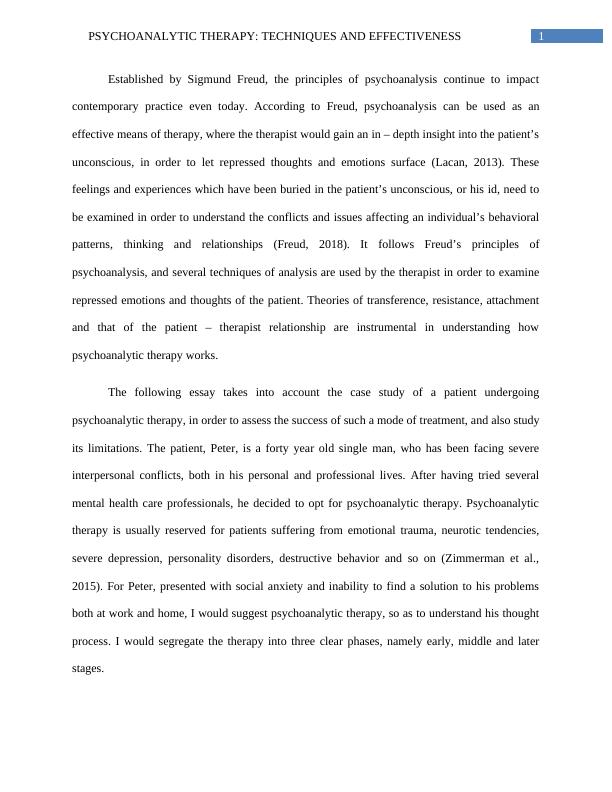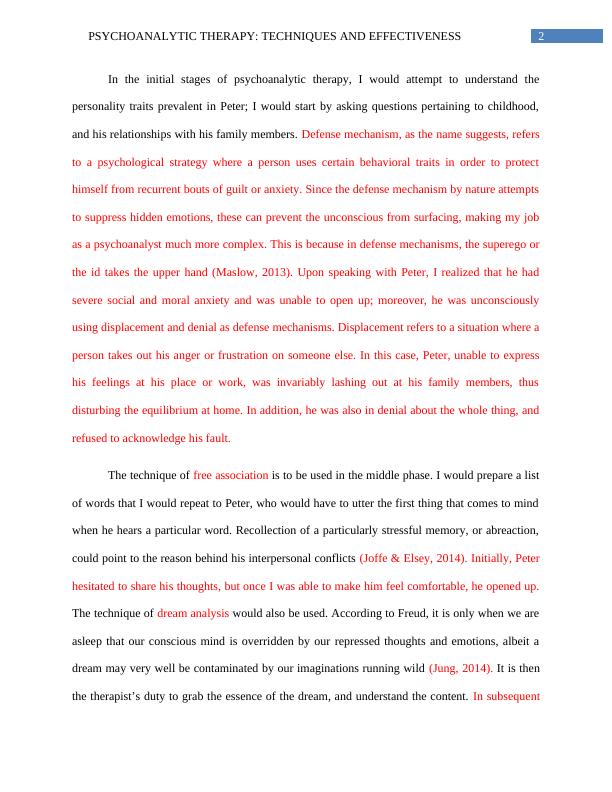Psychoanalytic Therapy: Techniques and Effectiveness
Added on 2023-06-10
10 Pages2955 Words172 Views
Running head: PSYCHOANALYTIC THERAPY: TECHNIQUES AND EFFECTIVENESS
Psychoanalytic therapy: Techniques and effectiveness
Name of the student:
Name of the university:
Author note:
Psychoanalytic therapy: Techniques and effectiveness
Name of the student:
Name of the university:
Author note:

1PSYCHOANALYTIC THERAPY: TECHNIQUES AND EFFECTIVENESS
Established by Sigmund Freud, the principles of psychoanalysis continue to impact
contemporary practice even today. According to Freud, psychoanalysis can be used as an
effective means of therapy, where the therapist would gain an in – depth insight into the patient’s
unconscious, in order to let repressed thoughts and emotions surface (Lacan, 2013). These
feelings and experiences which have been buried in the patient’s unconscious, or his id, need to
be examined in order to understand the conflicts and issues affecting an individual’s behavioral
patterns, thinking and relationships (Freud, 2018). It follows Freud’s principles of
psychoanalysis, and several techniques of analysis are used by the therapist in order to examine
repressed emotions and thoughts of the patient. Theories of transference, resistance, attachment
and that of the patient – therapist relationship are instrumental in understanding how
psychoanalytic therapy works.
The following essay takes into account the case study of a patient undergoing
psychoanalytic therapy, in order to assess the success of such a mode of treatment, and also study
its limitations. The patient, Peter, is a forty year old single man, who has been facing severe
interpersonal conflicts, both in his personal and professional lives. After having tried several
mental health care professionals, he decided to opt for psychoanalytic therapy. Psychoanalytic
therapy is usually reserved for patients suffering from emotional trauma, neurotic tendencies,
severe depression, personality disorders, destructive behavior and so on (Zimmerman et al.,
2015). For Peter, presented with social anxiety and inability to find a solution to his problems
both at work and home, I would suggest psychoanalytic therapy, so as to understand his thought
process. I would segregate the therapy into three clear phases, namely early, middle and later
stages.
Established by Sigmund Freud, the principles of psychoanalysis continue to impact
contemporary practice even today. According to Freud, psychoanalysis can be used as an
effective means of therapy, where the therapist would gain an in – depth insight into the patient’s
unconscious, in order to let repressed thoughts and emotions surface (Lacan, 2013). These
feelings and experiences which have been buried in the patient’s unconscious, or his id, need to
be examined in order to understand the conflicts and issues affecting an individual’s behavioral
patterns, thinking and relationships (Freud, 2018). It follows Freud’s principles of
psychoanalysis, and several techniques of analysis are used by the therapist in order to examine
repressed emotions and thoughts of the patient. Theories of transference, resistance, attachment
and that of the patient – therapist relationship are instrumental in understanding how
psychoanalytic therapy works.
The following essay takes into account the case study of a patient undergoing
psychoanalytic therapy, in order to assess the success of such a mode of treatment, and also study
its limitations. The patient, Peter, is a forty year old single man, who has been facing severe
interpersonal conflicts, both in his personal and professional lives. After having tried several
mental health care professionals, he decided to opt for psychoanalytic therapy. Psychoanalytic
therapy is usually reserved for patients suffering from emotional trauma, neurotic tendencies,
severe depression, personality disorders, destructive behavior and so on (Zimmerman et al.,
2015). For Peter, presented with social anxiety and inability to find a solution to his problems
both at work and home, I would suggest psychoanalytic therapy, so as to understand his thought
process. I would segregate the therapy into three clear phases, namely early, middle and later
stages.

2PSYCHOANALYTIC THERAPY: TECHNIQUES AND EFFECTIVENESS
In the initial stages of psychoanalytic therapy, I would attempt to understand the
personality traits prevalent in Peter; I would start by asking questions pertaining to childhood,
and his relationships with his family members. Defense mechanism, as the name suggests, refers
to a psychological strategy where a person uses certain behavioral traits in order to protect
himself from recurrent bouts of guilt or anxiety. Since the defense mechanism by nature attempts
to suppress hidden emotions, these can prevent the unconscious from surfacing, making my job
as a psychoanalyst much more complex. This is because in defense mechanisms, the superego or
the id takes the upper hand (Maslow, 2013). Upon speaking with Peter, I realized that he had
severe social and moral anxiety and was unable to open up; moreover, he was unconsciously
using displacement and denial as defense mechanisms. Displacement refers to a situation where a
person takes out his anger or frustration on someone else. In this case, Peter, unable to express
his feelings at his place or work, was invariably lashing out at his family members, thus
disturbing the equilibrium at home. In addition, he was also in denial about the whole thing, and
refused to acknowledge his fault.
The technique of free association is to be used in the middle phase. I would prepare a list
of words that I would repeat to Peter, who would have to utter the first thing that comes to mind
when he hears a particular word. Recollection of a particularly stressful memory, or abreaction,
could point to the reason behind his interpersonal conflicts (Joffe & Elsey, 2014). Initially, Peter
hesitated to share his thoughts, but once I was able to make him feel comfortable, he opened up.
The technique of dream analysis would also be used. According to Freud, it is only when we are
asleep that our conscious mind is overridden by our repressed thoughts and emotions, albeit a
dream may very well be contaminated by our imaginations running wild (Jung, 2014). It is then
the therapist’s duty to grab the essence of the dream, and understand the content. In subsequent
In the initial stages of psychoanalytic therapy, I would attempt to understand the
personality traits prevalent in Peter; I would start by asking questions pertaining to childhood,
and his relationships with his family members. Defense mechanism, as the name suggests, refers
to a psychological strategy where a person uses certain behavioral traits in order to protect
himself from recurrent bouts of guilt or anxiety. Since the defense mechanism by nature attempts
to suppress hidden emotions, these can prevent the unconscious from surfacing, making my job
as a psychoanalyst much more complex. This is because in defense mechanisms, the superego or
the id takes the upper hand (Maslow, 2013). Upon speaking with Peter, I realized that he had
severe social and moral anxiety and was unable to open up; moreover, he was unconsciously
using displacement and denial as defense mechanisms. Displacement refers to a situation where a
person takes out his anger or frustration on someone else. In this case, Peter, unable to express
his feelings at his place or work, was invariably lashing out at his family members, thus
disturbing the equilibrium at home. In addition, he was also in denial about the whole thing, and
refused to acknowledge his fault.
The technique of free association is to be used in the middle phase. I would prepare a list
of words that I would repeat to Peter, who would have to utter the first thing that comes to mind
when he hears a particular word. Recollection of a particularly stressful memory, or abreaction,
could point to the reason behind his interpersonal conflicts (Joffe & Elsey, 2014). Initially, Peter
hesitated to share his thoughts, but once I was able to make him feel comfortable, he opened up.
The technique of dream analysis would also be used. According to Freud, it is only when we are
asleep that our conscious mind is overridden by our repressed thoughts and emotions, albeit a
dream may very well be contaminated by our imaginations running wild (Jung, 2014). It is then
the therapist’s duty to grab the essence of the dream, and understand the content. In subsequent

End of preview
Want to access all the pages? Upload your documents or become a member.
Related Documents
Theories of Counsellinglg...
|10
|2576
|1
Counselling Theories: A Comprehensive Guidelg...
|10
|2847
|404
Psychoanalytic Versus Humanistic Approachlg...
|5
|1393
|58
(PDF) Journal of Personality and Social Psychologylg...
|7
|1498
|37
Introduction to Psychology: Psychoanalytic Approach and Behavioural Approachlg...
|5
|1384
|267
Psychoanalysis Theory Case Studylg...
|10
|2635
|296
